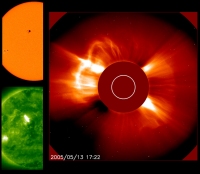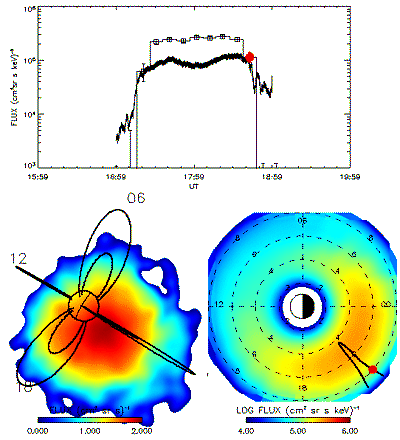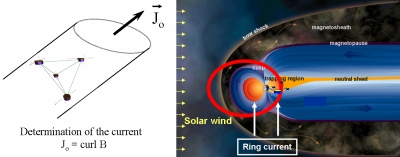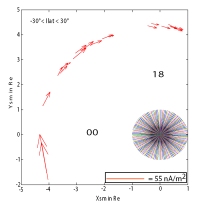First direct measurements of the ring current
28 July 2005
The first current density measurements in the ring current region, based on data acquired simultaneously by 4 spacecraft, have been published in Annales Geophysicae . The 4 spacecraft comprise the European Space Agency's Cluster mission. Analysis of 5 months of data allowed a partial mapping of the ring current region under various geomagnetic conditions. This information is of prime importance to quantitatively estimate the changes occurring in the ring current (for example the input of particles, amount of current created) during the development of magnetic storms.Geomagnetic storms are more than ever a major focus of space scientists worldwide. Recently published or in press, dedicated issues of three renowned scientific journals (GRL, JGR and Space Weather) gather new findings about violent magnetic storms which occurred in April 2002 and October-November 2003.
These latter magnetic storms had many impacts on Earth (such as radio blackouts and satellite link disruptions), in space (60% of NASA Earth observation and space science missions impacted) and even on Mars (rovers). But other significant magnetic storms stroke the Earth since, the most recent occurred just a few weeks ago, on 15 May 2005 (see Image 1 and related link "Classic Halo CME").
DST and the Richter scale
Similarly to Earthquakes and the Richter scale, scientists have defined an index (a number) to assess the severity of geomagnetic storms: the Disturbance Storm Time index or Dst. The more negative, the more intense is the storm (Image 2). But what is it exactly?
During a magnetic storm, the magnetic field measured at the Earth's surface weakens and Dst is a measure of this magnetic perturbation. Does it mean that the Earth's internal magnetic field is decreasing? No. However, a significant population of charged particles circulating around the Earth, in other words an electric current, could induce a magnetic field. Oriented in the opposite direction to the Earth's, it would be able to decrease the magnetic field measured at the Earth's surface.
The Ring current
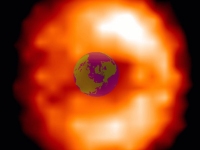 |
|
Image 3: The Earth superimposed on an image of a portion of the Ring Current, taken by the High-Energy Neutral Atom imager (HENA) onboard the NASA IMAGE spacecraft. (Credit: NASA) |
Even before the space era, it was theorized that the interaction of the solar wind with the Earth's magnetic field could imply the existence of a permanent torus of energetic charged particles around the Earth, trapped by the terrestrial magnetic field.
Measurements from various spacecraft, including the first US satellite in 1958 (Explorer 1), prove the existence of such a torus. This belt of particles was found to be composed of ions and electrons with a wide energy range. Due to the shape of this particle population, the resulting electric current was named the ring current (Image 3). Neutral atoms are also present in that region, trapped by the gravitational field.
All trapped charged particles contribute to the ring current's density. However, it was estimated that the particles carrying most of the current (~90 %) are ions of medium energy range, from ~15 keV to a few hundreds of keV. Depending on the geomagnetic activity, the ring current location, in the magnetic equatorial plane, extends radially from 2 to 9 RE (1 RE= 6378 km - the Earth's equatorial radius).
Note that other currents contribute to the Dst as well, most importantly the magnetopause current.
Another measurement first by Cluster
A lot has been learnt about the ring current in more than 40 years of spacecraft measurements. In particular, imaging of energetic neutral atoms emitted by the ring current, and performed by the NASA IMAGE spacecraft (Image 3), has given us a global picture of the ring current and its evolution during magnetic storms (Animation 1). But pieces of the puzzle are still missing. For instance, we know that magnetic storm strengthens it but what is the strength of the ring current during quiet time?
This information is of prime importance to quantitatively estimate the changes occurring in the ring current (for example the input of energetic particles, amount of current created) during the development of magnetic storms. In order to answer this question, the in-situ measure of an essential physical parameter is needed: the current density itself.
Attempts have been made in the past to derive this physical quantity by using either distribution functions of particles (pressure gradient method) or magnetic field measurements (curlometer technique based on Maxwell-Ampère's law) acquired by multiple passes of a single spacecraft. Why multiple passes? Because whatever the method, the estimation of the current density requires in-situ measurements from at least 3 different locations, up to a few hundreds kilometres apart.
As underlined in Vallat et al. [Annales Geophysicae Volume 23 Number 5 2005], assumptions used in past studies such a stationarity between two successive points of measurement did not allow getting an instantaneous picture of the ring current. These studies required indeed the same ring current density, at a given point, during the successive spacecraft orbital passes. However, the ring current is very dynamical by nature. To reduce the temporal effects limitations, a simultaneous multi-spacecraft analysis is thus necessary.
In 2002, for the first time ever, 4 spacecraft flying in close formation (~250 km inter-spacecraft distance) successfully provided accurate magnetic field measurements in the ring current region, enabling the first estimation of the in-situ current density based on simultaneous measurements (Image 5). These spacecraft comprise the European Space Agency's Cluster mission.
Cluster is the first scientific mission ever launched in space composed of 4 identical spacecraft flying in formation. Designed to study the impact of solar activity on the Earth's magnetosphere, they are orbiting the Earth from 4 RE to 19 RE with a flexible inter-spacecraft distance, since August 2000. Each spacecraft is equipped with an identical range of 11 scientific instruments including magnetometers and ion detectors.
Moreover, this measurement first was not unique. During 5 months (February - June 2002), the Cluster satellites stayed in the same geometrical configuration. Analysis of all ring current crossings allowed to establish the first partial mapping of the current density in the ring current region, based on four simultaneous points of measurements, under various geomagnetic activity levels (Image 4).
"This study allowed, for the first time, to measure the permanent ring current around the Earth. The knowledge of this current is essential for modelling the relative contribution to the Earth's magnetic field of the internal geomagnetic field and of the external sources", wrote Dr. Claire Vallat, lead author on the Annales Geophysicae paper. Dr. Vallat is a lecturer at Paul Sabatier University and affiliated to the Centre d'Etudes Spatiale des Rayonnements (CESR), CNRS, Toulouse, France.
In the near future, the analysis of Cluster measurements at other separation scales shall further illuminate our knowledge of the Earth's ring current, in particular by completing the mapping of the current density and better understand its coupling with the ionosphere and the plasmasheet.
Vallat, C., I. Dandouras, M. Dunlop, A. Balogh, E. Lucek, G. K. Parks, M. Wilber, E. C. Roelof, G. Chanteur and H. Rème, First current density measurements in the ring current region using simultaneous multi-spacecraft CLUSTER-FGM data, Annales Geophysicae, Volume 23, Number 5, 2005.
Related Articles
Contact
Claire Vallat, Centre d'Etudes Spatiale des Rayonnements, CNRS, Toulouse, France
Tel: +33-5-61-55-66-79
Web story author
Arnaud Masson, SCI-SH division, RSSD, ESA, The Netherlands
Telephone: +31-71-565-5634
Web story editor
Philippe Escoubet, SCI-SH division RSSD, ESA, The Netherlands
Telephone: +31-71-565-3454

